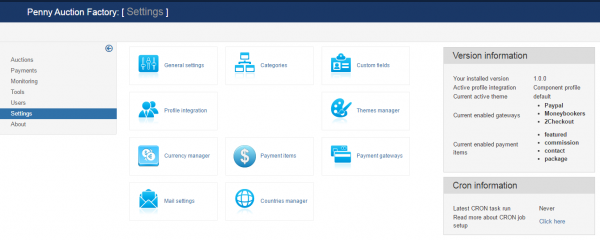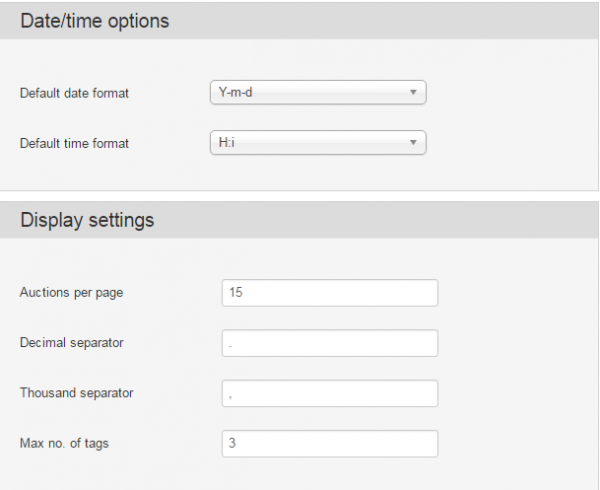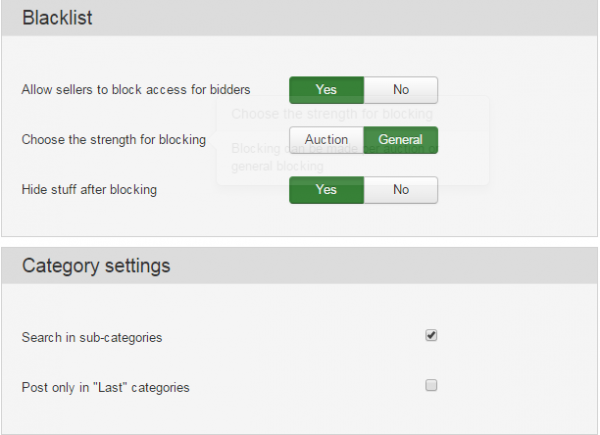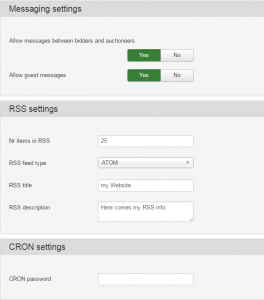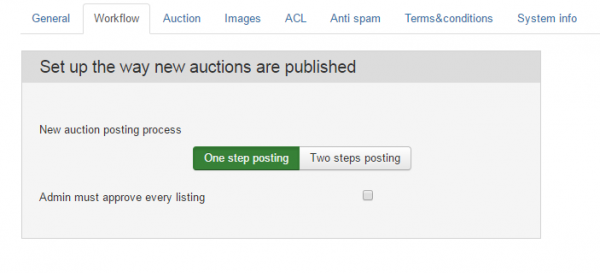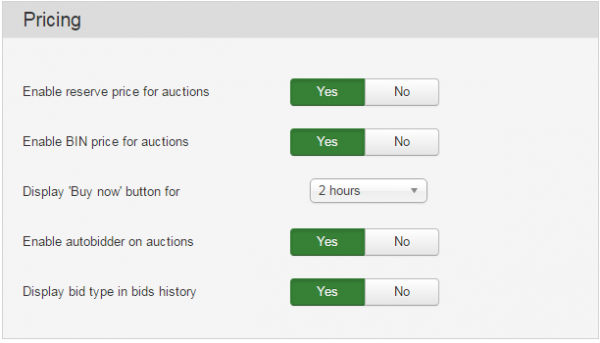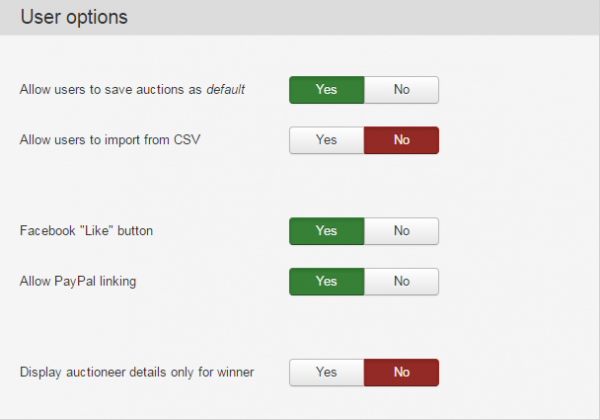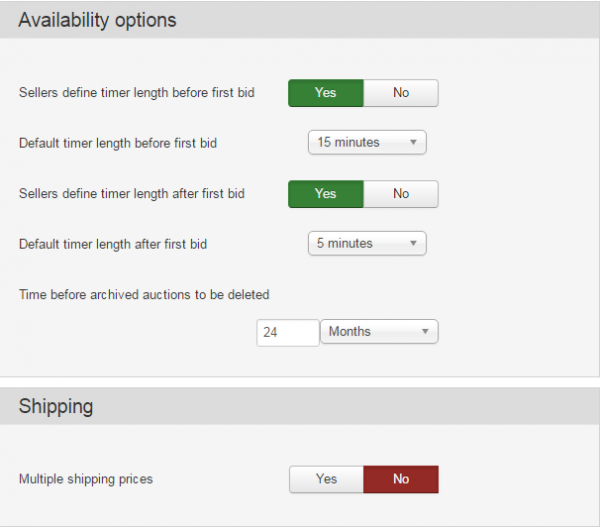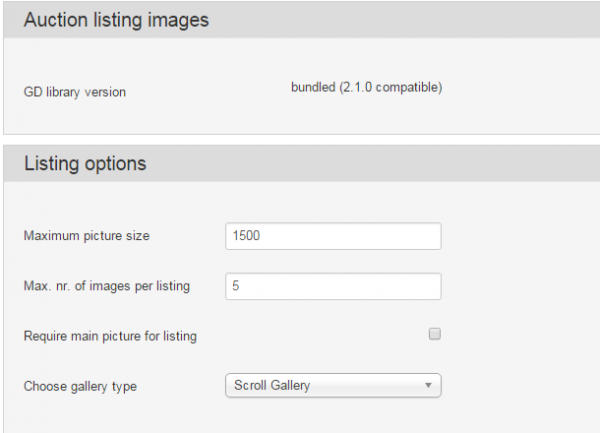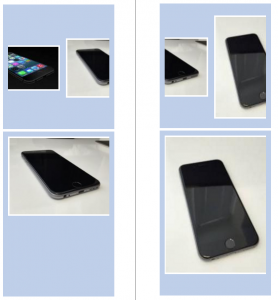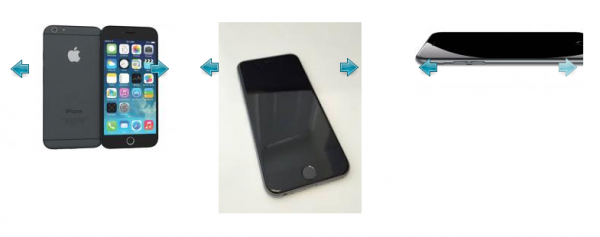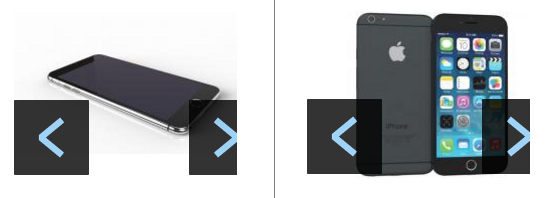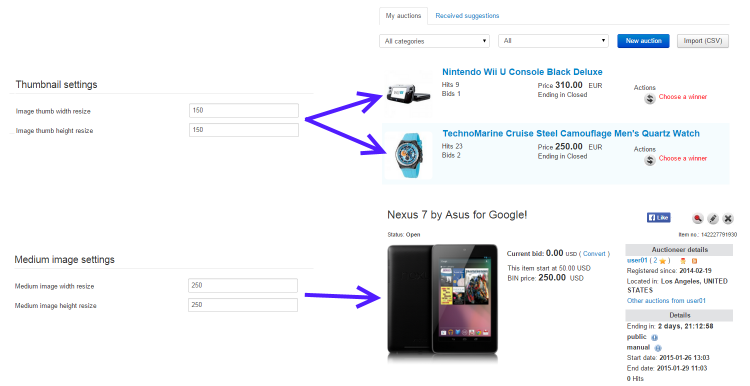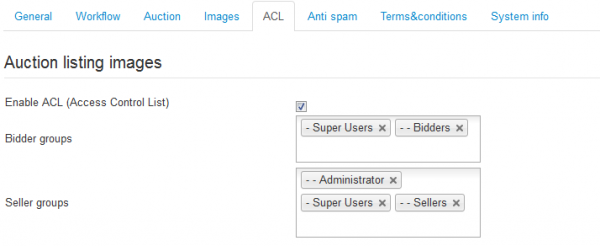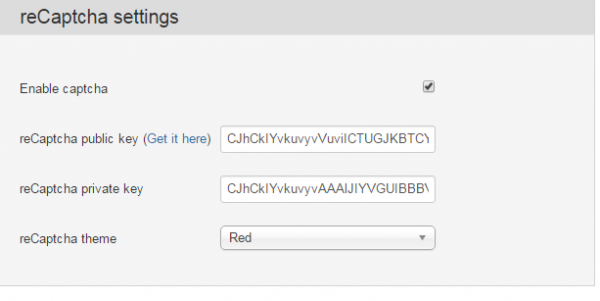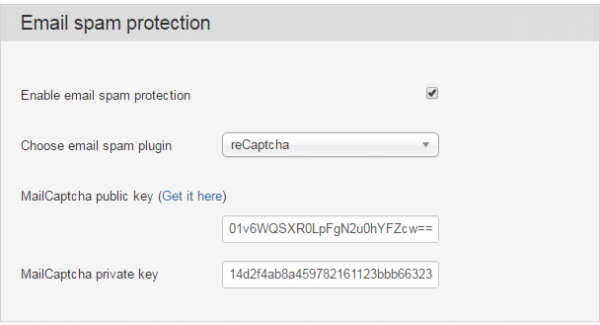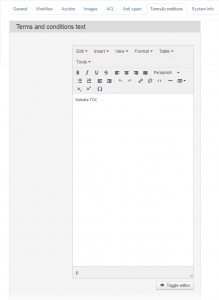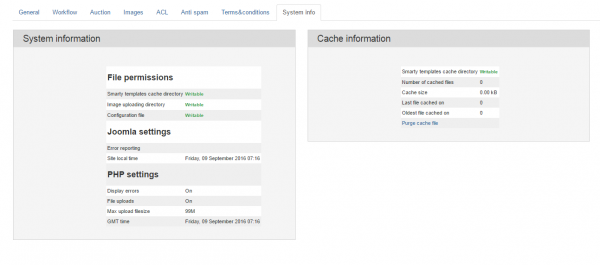Table of Contents
Configuration
Penny Auction Factory is a unique Joomla extension that allows you to create your own professional penny auction website.
Winner selection can be done automatically (best bid wins) or manually (by the auctioneer).
To configure your penny auction website, go to Components/Penny Auction Factory/Settings and click on General Settings.
General
Display Settings
1. Choose the desired Date and Time format for auctions, “d” stands for Day, “m” for Month and “Y” for year. “H:i” is for a 24-hour representation of time while “h:iA” is for a 12 hour format.
2. Auctions per page will set how many auctions will be displayed on listings. If the respective number is exceeded, pagination will be created.
3. Enable countdown adds a timer for each auction displayed in the listings, which represents the amount of time left until that auction closes.
4. Define how the prices will be displayed by setting up the Number of decimals and the separators for decimals and thousands.
5. From this section you can also set the Max Number of Tags allowed per auction. Tags are an excellent way for auctions to be filtered in a search. However, if a user puts too many tag words his auction will pop up in every search. Some people may find this annoying. To ensure this does not happen, you should leave a decent limit on your tags, making the posters choose only the tags that are suited for his ad.
Blacklist and Category Settings
1. If the Allow sellers to block access for bidders option is enabled, it gives the seller the ability to add specific bidders on his personal Blacklist. These bidders won't be able to access the respective seller auctions, to send him messages and any additional actions.
2. For the Choose the strength for blocking option you can select how powerful the blocking is, either per auction or general blocking.
3. Since blocking a user will make him unable to bid or sent messages to the respective seller, you can also enable Hide stuff after blocking. This will hide the messages and bids.
4. With Search in sub-categories you can set the search filters to also look for results in the sub-categories of the selected category.
5. Enabling Post only in "Last" categories will restrict you from posting auction in categories which have sub-categories.
Messaging, RSS and CRON Settings
1. A messaging system can be used which will allow bidders to interact with the auctioneers and vice versa.
2. You can also enable Allow guest messages which will give guests the possibility to write messages on auctions. However, it is highly recommended that you enable and set up ReCaptcha for this, to avoid any unwanted bot spam.
An RSS Feed is also available with our component. You can set it up from the RSS settings area.
3. Define Nr items in RSS to set how many auctions will be displayed within the feed.
4. Select the RSS feed type you wish to be used. You can choose between RSS2.0, RSS1.0, OPML, ATOM and more).
5. Customize your RSS feed according to your website by adding a Title and a Description.
6. Set a CRON Password which will be used to safely call the CRON script.
Workflow
From the Workflow tab, certain processes related to the auction workflow can be set.
You can choose from 2 different ways in which the users can post their auctions:
- a one-step posting where all the auction information is entered in one page.
- a two-step posting, which will require users to set the category first and then the rest of the details.
Besides ACL, the auctions can also be actively moderated. By enabling the Admin must approve every Listing option, all auctions will need to be manually approved by an admin on the backend before publishing them.
If you are an administrator, you can approve auctions by going to Components/ Penny Auction Factory/ Auctions .
Auction
Here you can set certain options for Pricing and Users, which will influence the auction listings.
Pricing
- Enable reserve price for actions - A minimum amount that the owner of an item will accept as the winning bid in the auction. The reserve price prevents the auction from being won at a price that is lower than the item's owner will accept. The auction's starting price tends to start lower than the reserve price to encourage bidding, but is forced to end at or above the reserve price or the auction is canceled.
- Enable BIN price for actions - BIN stands for Buy It Now, and if you set this option to Yes, you will be able to set the BIN value.
- Display 'Buy Now' button for - the amount of time the 'Buy Now' button will be displayed within an auction.
- Enable autobidder on actions - enables autobidding.
- Display bid type in bids history
User options
- Allow Users to save auctions as default will enable a feature that will record values from certain fields when creating an auction. Those fields will be auto-filled on the respective user's future auctions. A special tab will also be available on his profile, where he can edit these values. To change those default values the seller can also check a box in the auction form.
- Enabling Allow users to import from CSV will add a button on the My Auctions page, which users can click to bulk import auctions. The users will do so by uploading a CSV file with the certain structure and an image archive that corresponds to the uploaded CSV. The Proper structure has to be followed in the CSV in order for the import to work as intended. (You can see the structure here. The link we provided is made for Dutch Factory, but the same structure applies for Penny Auction, as well)
- You can choose to display a Facebook "Like" button on all auction detail pages and user profile pages by enabling the Facebook "Like" button option found here.
- Allow PayPal linking will allow auctions' winner to use sellers' PayPal address to pay. If the seller filled in the PayPal field on his profile, then a button will be displayed, which will be visible to the winners of all of his auctions. This button will redirect the bidder to PayPal, sending the bid value, so that the payment between seller and winner can be made.
- With Display auctioneer details only for winner you can either display the contact details of sellers to all the users or hide them and make them available only for the winner bidders and only for the auctioneer. This is available for privacy purpose.
Availability Options & Shipping
- Sellers define timer length before first bid - choose whether the auction starts right away or not.
- Default timer length before first bid - if the previous option is set to Yes , here you can set the time before the start of the auction.
- Sellers define timer length after first bid - choose whether the bidder can bet right away after the first bid or not.
- Default timer length after first bid - if the previous option is set to Yes , set the time bidders can bid once the first bid was made.
- Time before archived auctions to be deleted
- Set Multiple shipping prices, depending on the shipment distance towards the buyer.
Images
On the Auction Listing Images fieldset you can check the current version of the graphic library.
1. Set a Maximum picture size, where, if a picture of a bigger size is being uploaded, it will cancel the upload and inform the user about the maximum allowed size.
2. To prevent any over-flood on your website you can limit the Max. nr. of images per listing.
3. Require main picture for listing will make the main picture required for all new listings. This is useful since an auction which has at least a main picture can be seen as more trustworthy.
4. There are three different Gallery Types you can choose: Scroll Gallery, Lytebox and Picture Slider. Be sure to check them one by one to see which one of them suits your website better (also depending on the used Joomla template).
Scroll Gallery
By using this type of gallery, you can switch the images if you click on them. Firstly, you have the images displayed one after another (scroll the images horizontally by moving the mouse cursor inside the box) and you can select a photo to be displayed below the gallery; you can move to the next picture by clicking on the shown image.
If you choose Lytebox or Picture Slider, you can see all the images one by one, using the previous and next buttons to change the image.
A click on the selected image opens the full picture in a pop-out window.
Lytebox
Picture Slider
There are two sizes of images that can be set by you on this page. These are not for the full sized versions but for their thumbnails, which are displayed in the listings and auction details pages.
Thumbnail settings allows you to change the width and height of the images found on the listing pages such as My Auctions and List auctions. Medium image settings refers to the images which are displayed in the detailed view of each auction page.
(!) The full-size modal box which appears when clicking on the image is resized dynamically in Javascript according to the clients' resolution.
That means that for any resolution the browser has, the image is always centered and about 90% of the height or width available on screen.
Access Control List
From this tab, you can enable the ACL function of the component that will allow you to select which specific groups of users are allowed to post auctions or place bids on them.
It is recommended that you create 2 new groups for both and set proper access levels before setting this up.
For more information regarding the ACL please visit our Penny Factory - Access Control List Guide.
Anti Spam
To protect your website against unwanted spam you can use reCaptcha and email protection features such as reCaptcha Mailhide, this tab allowing you to set them up. The reCaptcha form will appear when guests attempt to post comments on auctions.
Check the Enable Captcha checkbox and then press on the Get it here link which will redirect you to ReCaptcha's website. Follow the instructions found there and copy/paste the public and private keys.
Optionally, you can change the reCaptcha theme to either Red, White, Backglass or Clean.
From the Email Spam Protection area you can enable one of the available email protection features by checking the checkbox and selecting which type you wish to be used.
The reCaptcha Mailhide works the same way as a regular reCaptcha, but it is used when users want to see email addresses. Other mail protection methods are Smarty and Joomla. Smarty obfuscates the source code with Javascript, while Joomla simply hides the email.
In case you choose reCaptcha Mailhide, you have to add a public and a private key, clicking on Get it here will take you to the ReCaptcha's website to obtain the public and private keys.
Terms & Conditions
This tab comes with a simple WYSIWYG editor where you can add your websites' Terms and Conditions.
Users will have to read and agree with the Terms and Conditions added by you on this editor in order to create new auctions or place bids.
System Info
The System Info tab is implemented to provide basic information about the cache directory, upload directory or configuration file. These are useful for debugging if any issues arise. The component handles the configuration file permissions itself, even if the configuration file might be Unwritable, the component will still be able to save the configuration and restore previous permissions.
(!) Documentation based on Penny Auction Factory version 2.0.1


